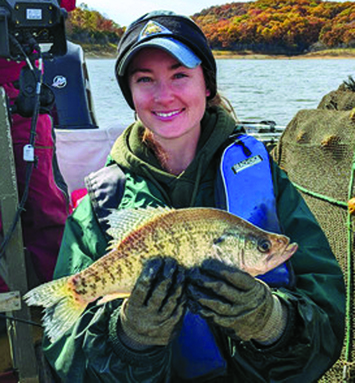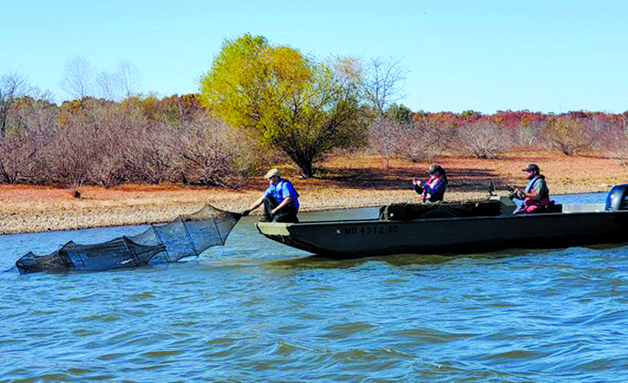When late autumn winds were putting a chill on Truman Lake, Missouri Department of Conservation Fisheries Management Biologist Chris Brooke and assistants were counting and measuring hundreds of crappie netted from the lake’s depths. Nature’s ancient processes guide the life patterns of fish like crappie. But anglers play a role in their ecosystem, too, at a heavily fished reservoir. Brooke was out on the water with the help of other MDC personnel in October to gather data used to track fish population trends.
Black crappie and white crappie, separate species that are closely related, are among Missouri’s most popular sport fish. They can be easily caught during the spring spawning season on small lures or bait like minnows. Many anglers consider them a favorite fish to eat and a year-round quarry. Truman Lake is one of the state’s most productive crappie fishing lakes, an enormous reservoir with varied water and habitat conditions. Crappie are panfish that must be 9 inches long or longer to be kept at Truman Lake. But they are numerous given a succession of good spawning years, a fish that’s important to the lake’s recreation economy.
MDC biologists scientifically monitor fish populations in Missouri waters to make sure they are healthy, and if not, possibly propose a regulation change. No regulation change is being considered for Truman Lake because crappie populations are good and relatively stable. The population sampling done with nets in autumn does enable a prediction for angler success. He expects 2023 to be a good year for crappie fishing. That’s helped by a large year-class of black crappie spawned in 2019 that have reached the legal length limit.
“I think we’re going to have an average year on Truman,” Brooke said of 2023. “But an average year on Truman still produces a lot of really good crappie fishing.”
When sampling crappie populations, biologists pull trap nets from the lake and process the fish. The crappie are identified by species, counted, and fish over five inches are measured. Most are then released back to the lake. Otoliths, an ear bone in fish, are removed from a few fish to determine the age. Data gathered goes into computer programs used to track population trends, such as growth rates. For example, the 2022 sampling showed that in the Windsor Crossing area of the lake on the Tebo Creek arm, 10 percent of the black crappie were over nine inches long and 48 percent of the white crappie were that size. Catch rates for both species were about the same.
Brooke sampled at six sites last autumn. Crappie numbers and average size varies between different lake locations. The middle and upper reaches of the Osage and South Grand River arms of the lake have higher percentages of white crappie than black crappie. Black crappie are sampled in higher percentages in the Pomme de Terre and Tebo Creek arms as well as the lower lake areas closer to the dam. White crappie dominate in the murkier arms of the lake. Black crappie are more numerous where water is more clear. The upper areas of the lake’s arms tend to have more larger fish, while the lower areas have more fish.

MDC Fisheries Management Biologist Chris Brooke and other MDC staff members netted crappie last fall to gather data used to monitor trends for fish populations in the lake.
Missouri Department of Conservation photos
For an angler, catching crappie comes down to knowledge of fish habits, skill, and some luck regarding weather and baitfish patterns. Also required is if fish happen to be hanging out and hungry where a baited hook on a line is dropped down into the water. Uncertainty helps make fishing an adventure.
For more information about Truman Lake fishing, visit MDC’s Fishing Prospects page at https://short.mdc.mo.gov/4gH. For a YouTube video of Brooke removing an otolith to determine a crappie’s age, visit https://short.mdc.mo.gov/4gV.



Facebook Comments